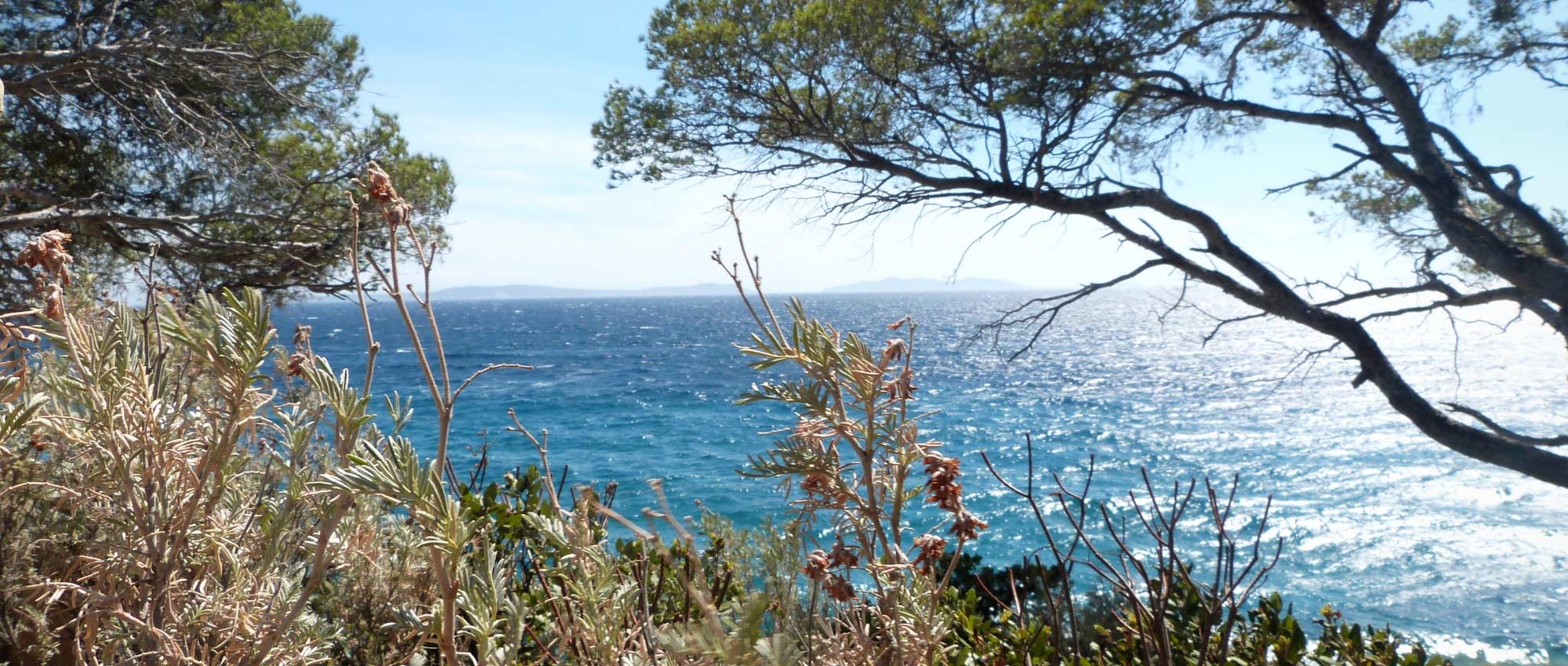
10 perfect bushes for a seaside garden
Most suitable varieties
Contents
As well as offering a beautiful natural setting, seaside gardens benefit overall from a mild, sunny climate favourable for growing less hardy plants. However, they are subject to harsh conditions: strong winds, salt spray, poor sandy soil that drains very quickly, etc. You therefore need to grow resilient plants capable of adapting to this particular environment.
Planting bushes there will allow you to create windbreaks, so creating conditions suitable for growing more delicate plants. Evergreen bushes are useful because they form a screen that will protect against wind even in winter. However, to create a hedge you can mix deciduous and evergreen bushes. Choice of bushes for your garden also depends on your geographical location: hydrangeas, for example, are perfect on the Brittany coast, whereas oleanders suit Mediterranean gardens better. Also feel free to take inspiration from spontaneous vegetation, plants that grow naturally on the coastline. To help you make your choice, discover our selection of 10 bushes that thrive in seaside gardens!
Elaeagnus, oleaster
Elaeagnus, also called Chalef, is ideal for hedging as it forms an effective windbreak thanks to its fairly dense foliage. It is hardy and tolerates salt, sand and sea spray fairly well. In addition, it grows quickly. It helps protect more fragile plants by reducing wind and sand movement. It is a bush with single, entire, ovate leaves, rather ordinary but offering lovely colours. Depending on varieties, they can be grey, green, or variegated with yellow. Those of Elaeagnus angustifolia resemble olive leaves (hence the common name “Bohemian olive”). This species is deciduous while Elaeagnus ebbingei is evergreen. The flowering of these bushes is rather inconspicuous.
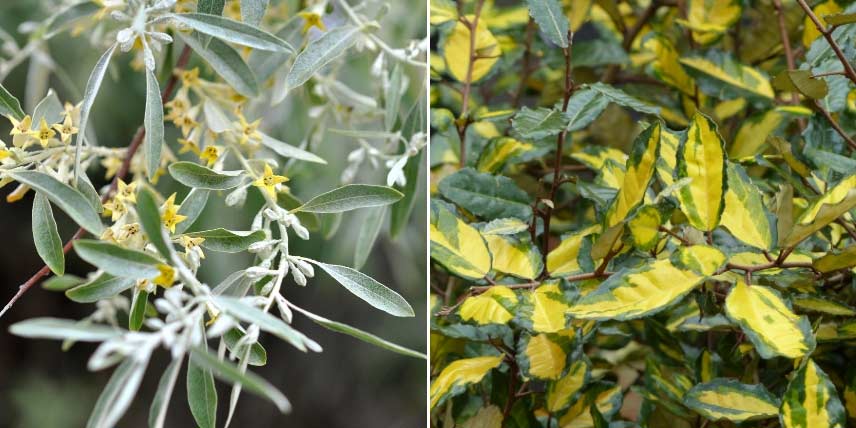
Elaeagnus angustifolia (photo Lazaregagnidze) and Elaeagnus ebbingei ‘Limelight’
Read also
Coastal garden designGriselinia littoralis
This bush bears beautiful soft, shiny, bright green foliage, slightly yellowish. Its leaves are single, ovate and glossy. Thanks to its dense, compact, very bushy habit, it is ideal for planting as a hedge. It grows quickly and has the added advantage of being evergreen! However, its flowering and fruiting are very inconspicuous, rather insignificant. The species Griselinia littoralis is mainly grown. It favours sandy, well-drained soils but is sensitive to cold winds. You can plant it in full sun or partial shade. It forms an effective windbreak against sea spray for growing more delicate plants.
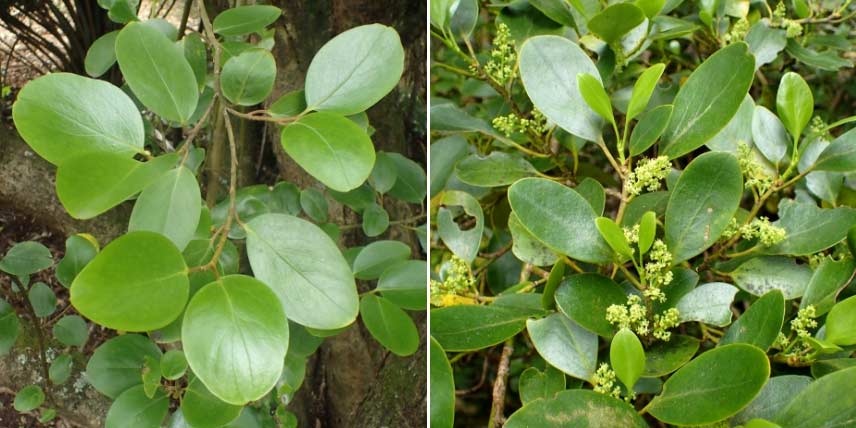
Griselinia littoralis (photos Krzysztof Ziarnek, Kenraiz)
Tamarisk
Tamarisk is a deciduous bush that offers impressive flowering thanks to a multitude of small flowers, pale pink or deeper. It is appreciated for its airy, very light appearance, due both to the fineness of its foliage and its airy flowering! Leaves are green and very small, deciduous, borne on flexible stems. Depending on species, tamarisk can flower in spring or summer. Very hardy, tolerates salt, sea spray and wind, and requires little maintenance. You can plant it as a hedge, but it is also attractive as a specimen or in a small group, for example in a short grass meadow, to bring out its elegant silhouette.
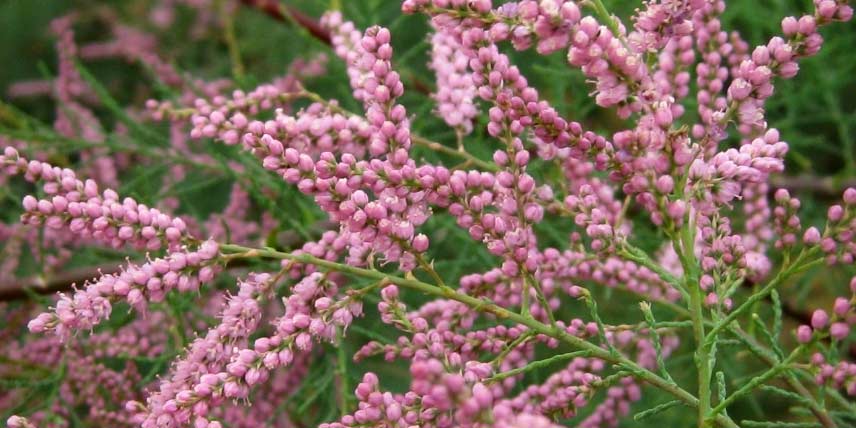
→ To find out more, discover our factsheet “Tamarisk: Planting, pruning and care”
Strawberry tree, Arbutus unedo
Strawberry tree is a bush naturally found around the Mediterranean basin. In autumn it bears small white bell-shaped flowers that give rise to globose fruits, decorative and edible, somewhat resembling strawberries (hence its common name ‘strawberry tree’). Flowers are also melliferous, attracting pollinating insects. Its leaves are green, evergreen and dentate. Over time its trunk becomes gnarled and bears a superb reddish bark that peels. Its growth is fairly slow, but it can live for a very long time! It will easily find a place in an informal hedge but can also be planted as a specimen.
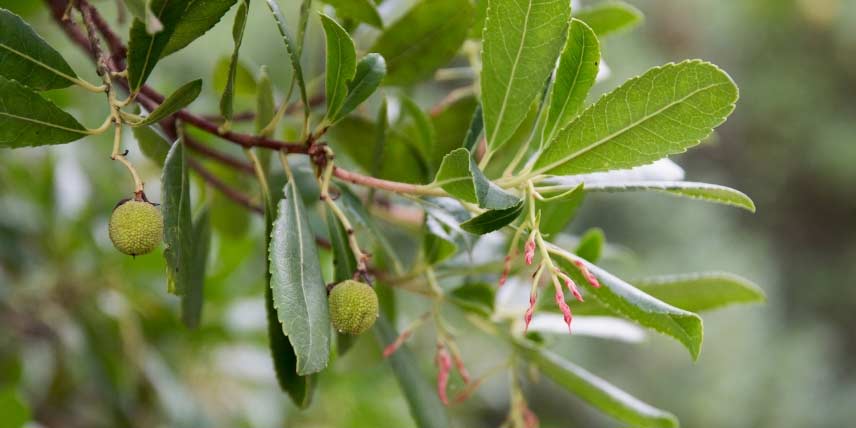
Arbutus unedo (photo Daniel Villafruela)
Pittosporum
Pittosporum tobira, also called Japanese pittosporum, is a bush with a rounded, dense habit and evergreen foliage. It bears single, dark green, glossy leaves. In spring enjoy its fragrant white flowering. The flowers form small star-shaped bells and are gathered in terminal umbels. There are even dwarf varieties, such as Pittosporum tobira ‘Nanum’, which does not exceed one metre in height (compared with 5 m for type species)! Pittosporum is sensitive to cold winds, but tolerates pruning well, and can be grown in a pot.
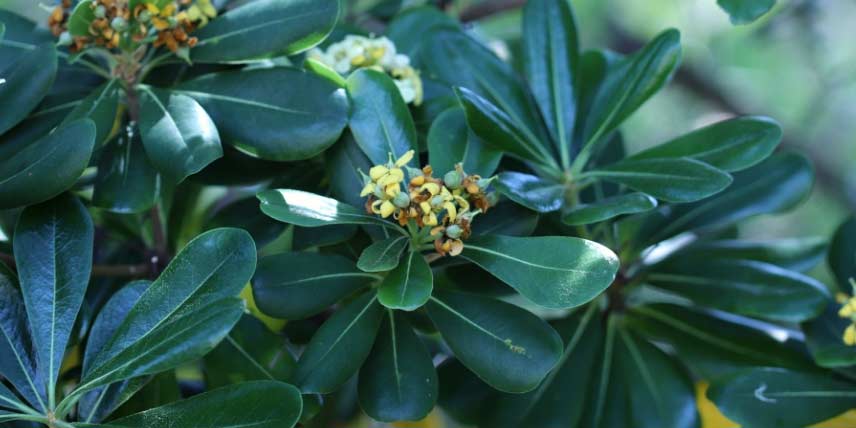
→ For everything you need to know, see our fact sheet on planting, growing and pruning Pittosporum
Rockrose
Cistus is a small evergreen bush that offers, between spring and early summer, white or pink flowers, compound of five crinkled petals, with a cluster of yellow stamens at the centre. This flowering brightens the garden! In addition, sometimes the petals bear darker maculate markings towards the centre of the flower, which provides a superb contrast. The leaves of Cistus can take different shades depending on species and varieties: green, grey, yellow… They are single and elongated, sometimes sticky and tacky. It is a bush that tolerates very well poor, dry and stony soils.
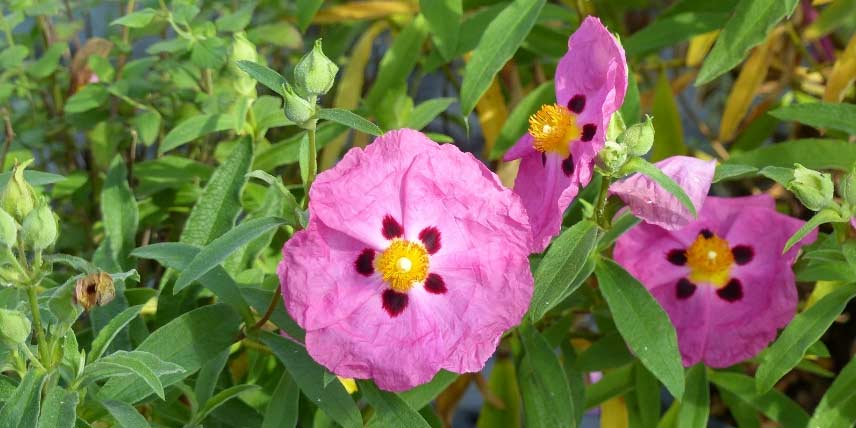
Cistus purpureus
→ Discover our plant sheet dedicated to Cistus
Olearia
Olearia is an evergreen bush with grey-green, fairly dense foliage. It also produces abundant white flowering, made up of numerous flowers resembling small heads. It grows quickly, becomes bushy and dense, and makes an excellent windbreak. Generally it can reach up to 4 metres in height and has fairly flexible branches. It is best to prune from time to time to maintain a dense, relatively compact habit. The species Olearia virgata has very thin, linear leaves, whereas those of Olearia traversii are ovate and much broader. Other species are also found in cultivation, such as Olearia x haastii and O. solandri.
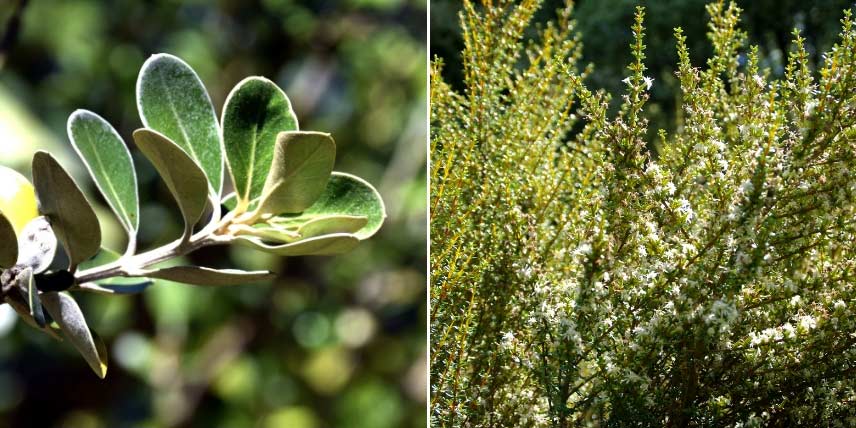
Olearia traversii (photo Krzysztof Golik) and Olearia solandri ‘Aurea’
→ Find out more with our full factsheet on Olearia
Escallonia macrantha
Escallonia is a bush with evergreen, dark green, glossy foliage. Leaves are fairly small, ovate and dentate. It is also prized for its small tubular flowers, generally pink-red, although there are also varieties with white flowers. The corolla is formed of five petals fused into an elongated tube. Escallonia grows quickly, and the largest varieties can reach 3 m in height, but there are also groundcover varieties, such as Escallonia ‘Red Carpet’, which does not exceed 80 cm in height.
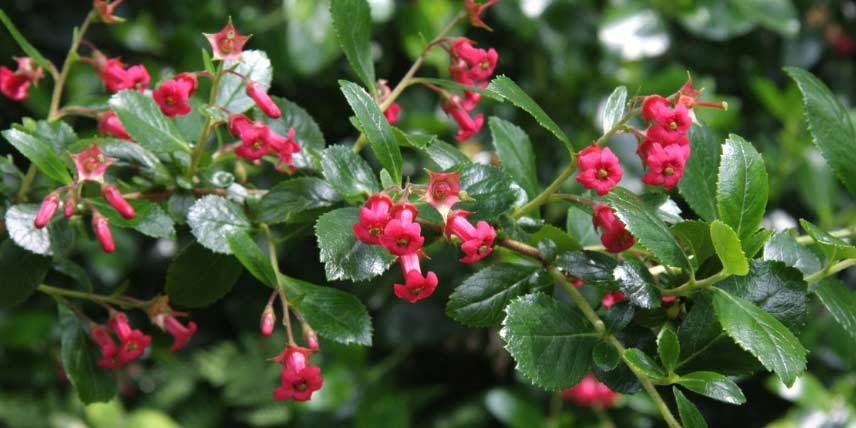
Escallonia rubra ‘Crimson Spire’ (photo Ben Rushbrooke)
→ To learn everything about Escallonia and how to grow it, follow our advice: “Escallonia: planting, pruning, maintenance”
Yucca
Yucca is ideal for bringing an exotic touch to your garden! It provides structure and verticality to borders. It produces one or more trunks, sparsely ramified, from which a tuft of long, narrow leaves unfolds. You can find varieties with green, blue or variegated foliage in cream-white or yellow. When flowering, Yucca bears an erect spike of white, bell-shaped flowers. Species Yucca filamentosa and Yucca gloriosa are among the hardiest, able to withstand down to -20°C or even -25°C! In the garden, we recommend planting your Yucca in a sunny spot. You can pair it with palms, callistemon, phormiums, agaves and other plants with an exotic look!
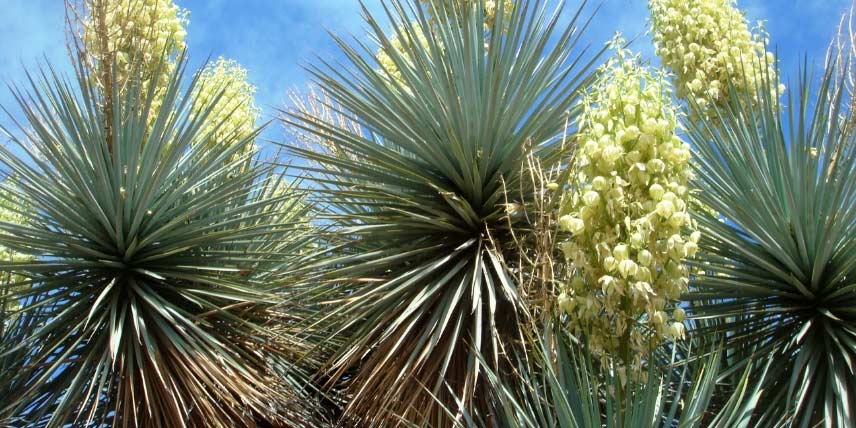
Yucca gloriosa (photo: Miwasatoshi)
→ Follow our advice for successful planting, cultivation and care of Yuccas
Callistemon, 'Bottlebrush'
Callistemon, also called bottlebrush, is a bush native to Australia that produces distinctive elongated inflorescences, bottlebrush-shaped, in warm tones: red, pink, orange… even cream-yellow for Callistemon pallidus. The inflorescences are decorative thanks to the numerous long thread-like stamens that compose them. Callistemon also has handsome single, elongated, leathery leaves. They are evergreen. It is a bush that tolerates wind and sea spray well. You can include it in a hedge, alongside Grevillea and Leptospermum.
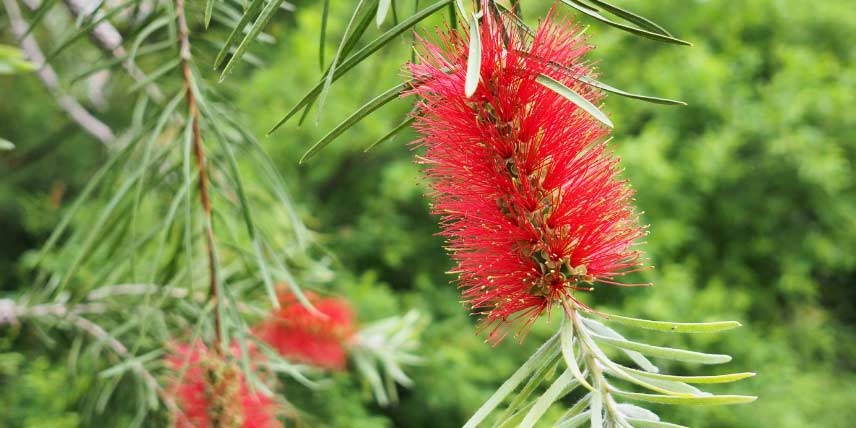
Callistemon rigidus
→ More information on Callistemon in our factsheet: “Callistemon, bottlebrush: plant, prune and maintain”
- Subscribe!
- Contents
































Comments